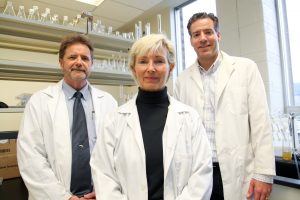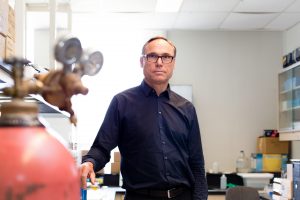Water plays a critical role in our lives. According to the United Nations Environment Programme (UNEP) “the total usable freshwater supply for ecosystems and humans is 200,000 km3 of water, which accounts for only 0.01 per cent of all water on earth.” By 2050 global water demand is projected to increase by 50 per cent due to growing manufacturing, thermal electricity generation and domestic use.
As global water scarcity and stress persist, solutions are needed to reduce pressure on freshwater assets. Now, more than ever, a focus on innovation is necessary to combat water challenges.
The newly established Institute for Water Innovation (IWI) at the University of Toronto is poised to address these challenges. According to Mandeep Rayat, Manager of IWI, the Faculty of Applied Science & Engineering has over 30 principal investigators from all the major engineering disciplines with research interests related to water. Seven of these researchers are in the Department of Civil Engineering.
The Department of Civil Engineering is playing a key role in addressing water challenges that affect human health, economic development and political stability.
Drinking Water Research Group: Clean water for cities
The Drinking Water Research Group (from top left: Profs. Robert Andrews, Susan Andrews and Ron Hofmann) examine all aspects of drinking water, from distribution optimization to new treatment technologies.
 “People in the water industry are very passionate about public health and that’s always at the forefront of any water treatment experiments,” explains Andrews. “What we do every day affects millions of people. Our research is done quietly but it’s really important. There are strong researchers in Canada working really hard who are truly focused on the health of Canadians and those around the world.”
“People in the water industry are very passionate about public health and that’s always at the forefront of any water treatment experiments,” explains Andrews. “What we do every day affects millions of people. Our research is done quietly but it’s really important. There are strong researchers in Canada working really hard who are truly focused on the health of Canadians and those around the world.”
With over 25 ongoing projects, the DWRG typically undertakes collaborative projects examining treatment, distribution, compliance and innovation to meet future water needs. By partnering with municipalities, a broad range of issues can be examined and knowledge transferred directly to utilities, regulators and policy-makers.
Jennifer Drake: Permeable pavement, rain gardens, green roofs
 Prof. Jennifer Drake is looking forward to the future when her urban-based research on permeable pavements, rain gardens and green roofs will benefit from the collaboration at the IWI. “We know that these [technologies] work, but if you put them all in one neighbourhood, how do they work together? Do they interact? Can they mitigate the impacts that urbanization traditionally has on our water resources? This is long-term research where we can see how sustained small changes can make a huge impact on urban living.”
Prof. Jennifer Drake is looking forward to the future when her urban-based research on permeable pavements, rain gardens and green roofs will benefit from the collaboration at the IWI. “We know that these [technologies] work, but if you put them all in one neighbourhood, how do they work together? Do they interact? Can they mitigate the impacts that urbanization traditionally has on our water resources? This is long-term research where we can see how sustained small changes can make a huge impact on urban living.”
Plans are already underway to increase opportunities for research investment and collaboration with industry partners to focus on water-related needs of private firms, whose primary issue is water remediation; mining and oil sands production require a lot of water and produce a lot of pollution, which makes water-based innovation necessary.
“We need to conduct research that looks beyond remediation and maximizes water usage,” explains Drake. “We’re trying to build U of T as a leader in water technology and sustainability and now we have something that can unite us and give us a bigger presence. We’re highlighting the water expertise by connecting mechanical, chemical and civil engineering so that we increasingly work together.”
Elodie Passeport: Harnessing wetlands to purify our water
Prof. Elodie Passeport’s research focuses on understanding the behaviour of water contaminants and testing passive water treatment system designs that optimize contaminant removal. The belief that environmental quality is a cornerstone of ecosystems and human health, helps drive her research.
 Why are wetlands important?
Why are wetlands important?
Natural wetlands are important ecosystems that help control flooding, improve water quality and provide multi-species habitats. Engineered wetlands are a low-cost, low-energy alternative to conventional water treatment systems.
Is it true that wetlands help to purify water systems?
Constructed wetlands can be engineered to enhance wetlands’ natural ability to remove pollution. By using natural energies from wind, sun, soil, plants and microorganisms living in the wetlands, the water is cleaned of contaminants. Early designs used single treatment units, often a pond with plants, but resulted in varying efficiency as not all chemicals could be removed in a single unit. A wide range of conditions are required to eliminate multiple chemicals, e.g. different pH, redox or plant densities.
Current approaches use multiple treatment units, each dedicated to one removal process, such as photodegradation in open-water ponds, or biodegradation in vegetated wetlands.
What are the applications for your research?
This research impacts storm water systems as well as municipal, industrial and agricultural wastewaters. By better characterizing the hydrological, physical, chemical and microbial processes governing contaminant levels in various passive water treatment systems, we can propose efficient, affordable and low-maintenance designs.
Brent Sleep: Cleaning up contaminated soil
Across the Canadian landscape sit thousands of forgotten sites that once housed industrial operations. These places, known as brownfields, suffer a tainted legacy of contaminated soil and groundwater that prevent their re-use and can threaten the surrounding environment.
 Most sites are contaminated by chemicals like chlorinated solvents, hydrocarbons, creosotes and coal tars, which can be difficult to remove. Just one litre of trichloroethene, a common industrial cleaner, can contaminate three million litres of groundwater. The worst aspect – these pollutants can persist for centuries in underground water sources.
Most sites are contaminated by chemicals like chlorinated solvents, hydrocarbons, creosotes and coal tars, which can be difficult to remove. Just one litre of trichloroethene, a common industrial cleaner, can contaminate three million litres of groundwater. The worst aspect – these pollutants can persist for centuries in underground water sources.
Prof. Brent Sleep and his Innovative Technologies for Groundwater Remediation research team work with the Institute for Water Innovation to address this challenge. Like a medicinal cocktail designed to defeat an aggressive infection, the group is investigating the enhanced effect that combining two or more different remedial technologies can have on contaminant removal.
Individually, innovative technologies like chemical oxidation, electro-kinetics, thermal remediation, and bioremediation can remove large amounts of contaminating particles. Real-world contamination, however, is highly complex. “Partnering complementary technologies addresses site complexities,” the group writes, “targeting both areas of very high contaminant concentration and areas of low – but still toxic – concentration.”
Sleep’s work aims to make brownfield cleanup more efficient, more cost-effective and more wide-spread.
Lesley Warren: Aqueous and microbial geochemistry
The largest workforce in mining isn’t found in any field camp or office tower. They aren’t wearing safety gear or business suits. They won’t be seen or heard, but their effect on mining operations can be profound. They are naturally-occurring microbes, and they are constantly influencing the water and soil environment.
 “Bacteria are present in every aspect of mining, but we don’t fully understand the impacts they can have on water quality,” says Prof. Lesley Warren, an aqueous and microbial geochemist with the Lassonde Institute of Mining and Dept. of Civil Engineering.
“Bacteria are present in every aspect of mining, but we don’t fully understand the impacts they can have on water quality,” says Prof. Lesley Warren, an aqueous and microbial geochemist with the Lassonde Institute of Mining and Dept. of Civil Engineering.
Warren aims to determine the identities and roles of microbes in order to gain an understanding of the bacteria’s beneficial—and detrimental—processes. Her research enables the development of effective biological tools for water quality management with industrial applications.
“Acid mine drainage is the number one priority pollution issue for the mining industry on a global scale,” said Warren. “It refers to the creation of acidic water. When sulfide minerals are exposed to water and air, sulfuric acid is generated through a natural, microbial-driven chemical reaction.”
Better understanding of the ecology of the microorganisms that are taking part in this process will help industry alleviate – or even prevent – polluting processes from occurring in the future.